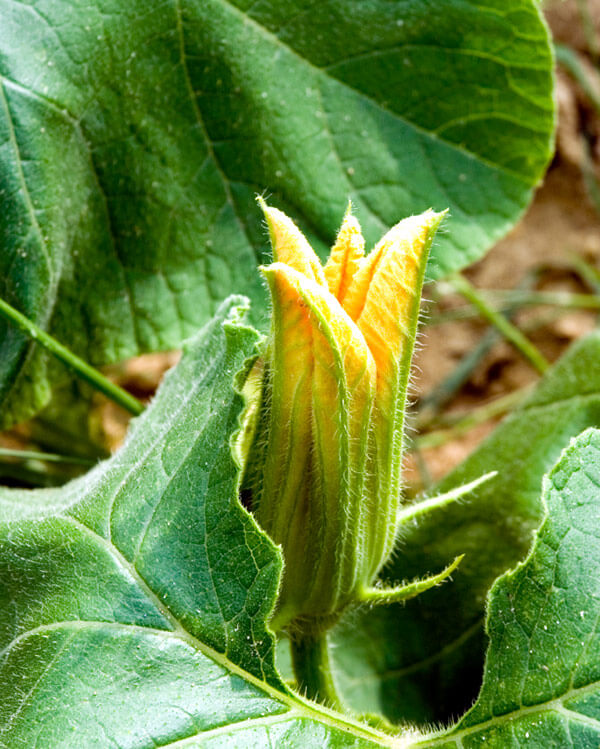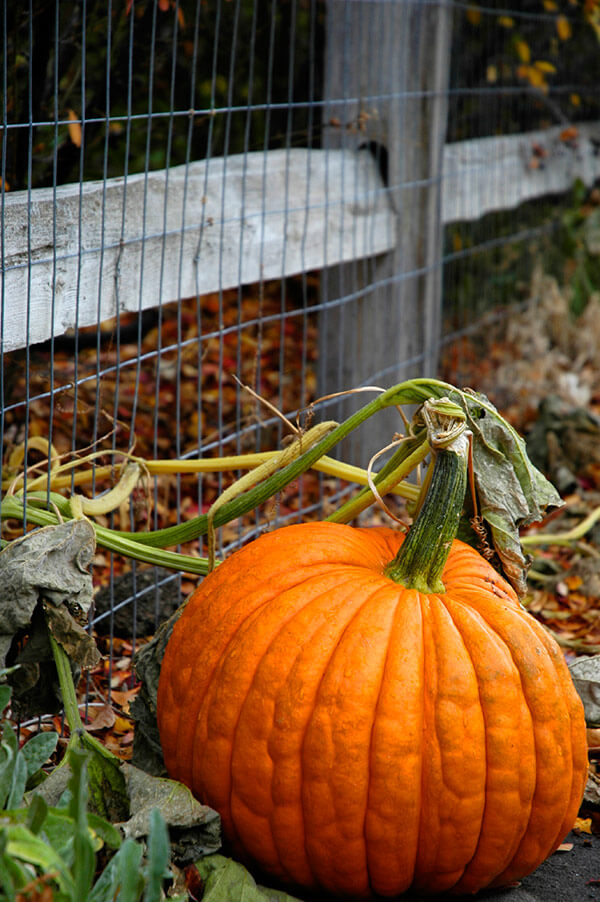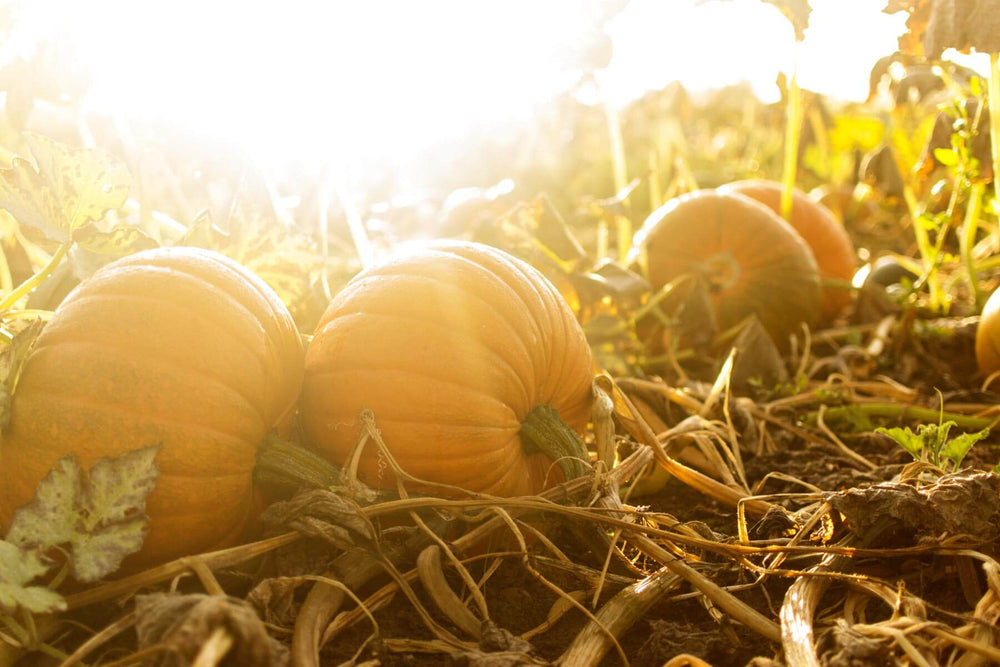Growing pumpkins stands as an enduring symbol of fall, whether they end up as smiling jack-o'-lanterns or stacked near cornstalks for a lovely autumn scene. But this vegetable boasts more than good looks. It's also full of nutrition, dishing up vitamin C, beta-carotene, fiber, and potassium. One half cup of cooked pumpkin provides a day's supply of vitamin A.
In the garden, pumpkins crave lots of moisture, compost-enriched soil, and plenty of sun. Meet those requirements, and these sprawling vines will bear a bumper crop, especially when you start with strong young pumpkin plants from Bonnie Plants®, the company that has been lending a hand to home gardeners for over 100 years.
Quick Guide to Growing Pumpkins
- Plant pumpkins in early summer near the edge of your garden.
- Space pumpkin plants 2 to 5 feet apart (depending on the variety). Grow each pumpkin on a 3-foot wide mound of warm, fertile soil that has a pH of 6.0 to 6.8.
- Improve your native soil by mixing in several inches of aged compost or other rich organic matter.
- Pumpkins require a lot of water, so it's best to use a soaker hose or drip irrigation. Avoid wetting the leaves.
- Give your pumpkins plenty of nourishment with a continuous-release plant food.
- As pumpkins start to form, elevate them off the soil to prevent rotting.
- Harvest pumpkins once they reach their ideal color. The skin should be firm and stems will have started to wither.
Soil, Planting, and Care
Like its cousin the cucumber, pumpkin demands warm, fertile soil for growth. Soil pH should be 6.0 to 6.8. Plan to give each vine at least a 3-foot diameter mound, or hill, of warm, enriched soil. Test your soil every year or two to determine how to amend it for ideal pumpkin growth. If you don't do a soil test, you can improve your existing soil by mixing in compost or aged compost-enriched Miracle-Gro® Performance Organics® All Purpose In-Ground Soil with the top few inches of native soil, to provide more nutrition and improve the soil texture. In cool climates, warm the soil a week before planting by covering it with a piece of black plastic. To plant your pumpkin seedlings, cut a hole in the plastic and plant through the hole.
Pumpkin vines grow aggressively, covering lots of ground. To keep your garden from being engulfed by vines, site plants near the edge of the garden. As vines grow, direct them toward the outside of the garden. Space full-size plants 5 feet apart, and mini pumpkins 2 to 3 feet apart.
Plants need ample water when flowers and fruits are forming. It is best to use a drip system or soaker hose to directly water soil at the base of vines so as to avoid wetting foliage. Try to water in the early morning, so that any water that splashes onto leaves can soon dry. Wet foliage is more susceptible to fungus, such as powdery mildew, which can slowly kill all the leaves on a vine. Most vines wilt under the bright, hot afternoon sun, but if you see foliage wilting before 11:00 a.m., that's a sign that they need water. It's also a good idea to feed pumpkin plants throughout the season with a continuous-release fertilizer like Miracle-Gro® Performance Organics® Edibles Plant Nutrition Granules, which provides a source of steady nutrition for strong growth.
Some gardeners promote branching to get more pumpkins by pinching the tips out of main vines when they reach about 2 feet long. You can also increase the yield on a vine by removing all female flowers (these have a small swelling at the base of the bloom) for the first 3 weeks. These practices may produce a sturdier vine that can set more, albeit smaller, pumpkins during the growing season if you have good soil, sun, and moisture. If your goal is fewer, larger pumpkins per vine, once you have 3 to 4 fruits on a vine, pinch off all remaining flowers as they form.
For a little fun, you can personalize pumpkins for children. While pumpkins are small and skins are soft, scratch a child's name into the skin. The name will increase in size as the pumpkin grows.
Troubleshooting
The first few flowers on pumpkin vines will be male blooms. Their pollen attracts bees so that when the female blossoms begin to open, the bees will have the pumpkin vines on their daily flight runs. Male flowers last one day, then drop from vines. If vines are stressed, male flowers may predominate. Insect pests of pumpkins include spotted and striped cucumber beetles, which can transmit bacterial wilt disease, which causes vines to collapse and die. Treat adult beetles with neem or pyrethrum. Be aware, however, that these are toxic to all insects, including beneficial predators and bees. Make applications at dusk to avoid harming bees.
Other insect pests include squash bugs, which must be controlled early or they can be devastating, and squash vine borers.
Powdery mildew, a fungus that produces white spots on leaves, can weaken plants.
For instructions on how to handle pests and diseases, contact your regional Extension agency.
Harvest and Storage
As pumpkins form, you can slip a piece of cardboard or folded newspaper beneath the fruit to prevent contact with soil and possible rot, especially if you are growing a precious few. Toward the end of the season, remove any leaves that shade ripening pumpkins. Harvest pumpkins before frost. Fruit is ripe when the outside is fully coloured, skin is hard, and the stem begins to shrivel and dry. Pumpkin vines are often prickly, so wear gloves and long sleeves when harvesting to keep from itching. To harvest, cut stems with a sharp knife, leaving at least an inch of stem on fruits (more stem is better). Lift pumpkins by slipping your hand under the bottom of the fruit. Never lift a pumpkin by its stem; if the stem breaks, the pumpkin won't store well.
Before storing, cure pumpkins by setting them in the sun for 10 to 14 days to harden the skin, seal the stem, and improve taste. Dry, warm weather is best; protect curing pumpkins from frosty nights with old blankets or by moving them into a shed or garage. Store cured pumpkins in a cool place, arranging them so they don't touch. The ideal storage space has a temperature of 50 degrees with about 60 percent humidity, but since a root cellar is hardly standard in most homes, do the best you can in a basement, vermin-free crawl space, or other frost-free storage. Under ideal conditions your cured pumpkins should store for 2 to 3 months.




FAQs
How do I know when pumpkins are ripe and ready to harvest?
Pumpkins should be harvested before the first hard frost. Vines die back and leaves shrivel at the end of the growing season. The fruits change from green to yellow to sunset orange. Cut pumpkins from the vine when the rind is firm; leave several inches of stem attached to the fruit to avoid rot.
How do you prolong the life of a carved pumpkin?
Allow the pumpkin to sit for 30 minutes after carving. Dry out the cut areas and the insides with a towel. Coat the cut areas with petroleum jelly. This reduces moisture loss and helps protect against rot for a few days.
How long can pumpkins be stored?
If kept in a cool dry space, pumpkins can last up to several months.




 Herbs
Herbs
 Vegetables
Vegetables
 Fruit
Fruit
 Flowers
Flowers
 Succulents
Succulents


